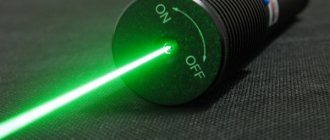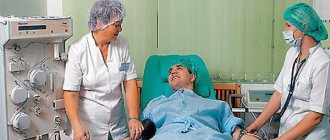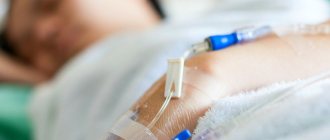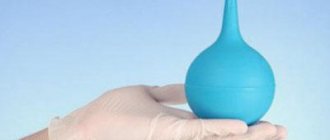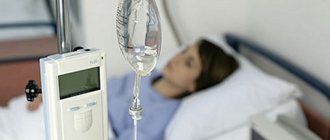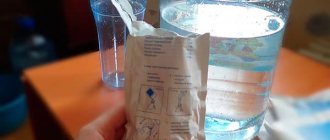Which is better: ILBI or ozone therapy?
Ozone therapy is a treatment using gas, which is a powerful oxidizing agent, which gives it a strong antiseptic property.
The effect of ozone on the body is similar to the effect of ILBI: bactericidal, vasodilating, analgesic, virucidal properties. Ozone thins the blood, improves immunity, affects the membrane of red blood cells, changing their chemical and physical properties. This improves oxygen supply to organs and tissues. Gas treatment occurs by administering a solution intravenously by drip, the procedure lasts about 30 minutes. Ozone therapy, like ILBI, is used to treat a number of diseases; it has contraindications and side effects that are observed in some cases. The treatment takes place over several sessions and is not painful at all.
In general, the effects and characteristics of both techniques are similar. The difference between gas therapy and laser cleansing is the possible negative consequences of an overdose, and the advantage is a more affordable price.
The article was approved by the editors
What is ILBI
ILBI has an effect on blood elements and corrects various disorders in the body
ILBI (intravenous laser irradiation of blood) is used in cardiology, dermatology, endocrinological practice, gynecology and other areas of medicine. Laser vessel cleaning is absolutely safe and has a number of advantages compared to other available techniques. Due to the unique action of the laser beam, it can be used in the treatment of other diseases: treatment of varicose veins on the legs with a laser, removal of hemorrhoids with a laser, etc. The indications and the procedure itself will differ from the laser blood cleansing technique.
The main task is to saturate the cells with oxygen and nutrients. Therefore, periodic cleansing helps reduce blood toxicity and strengthen the immune system.
The essence of the technique is to introduce an optical waveguide into an accessible vein and irradiate the blood vessels. Under the influence of a special apparatus, red light with a wavelength of 630 nm is supplied. Laser blood purification has no analogues, as it can significantly reduce the time of illness and gives maximum positive results. Action of ILBI:
- supplying cells with oxygen;
- immunostimulating;
- decongestant;
- anti-inflammatory;
- antioxidant.
After the cleansing procedure, general rejuvenation of the body occurs, weight is normalized, increased fatigue is relieved and mental abilities are increased. Blood cleansing also helps to get rid of bad habits (smoking, alcoholism) and improve health.
Laser blood irradiation is most often prescribed to patients with poor health or low immunity. The visible effect after laser therapy occurs after just a few sessions, and the general course consists of 5-10 procedures. The effect lasts for several months, and repeated cleaning can be done after three months.
Indications for use
Intravenous laser therapy has the following indications:
- acute and chronic inflammatory processes of different localization
complications after undergoing radiation therapy; postoperative period to accelerate wound healing and prevent complications; period of exacerbation of bronchial asthma; problems with blood clotting, tendency to form blood clots; recurrence of gastric ulcer after surgery; acquired lymphostasis, cerebrovascular insufficiency; consequences of burns; skin wounds with diabetes that do not heal for a long time; immunodeficiency conditions and dermatological pathologies.
Additionally, the technique is prescribed during the rehabilitation period after injury or surgery. It is an addition to physical therapy and drug treatment. It is used as a general strengthening procedure to stimulate the defense mechanism and increase resistance to various external irritants. Indicated for people who work in hazardous industries.
The procedure is most widespread in surgery:
- purulent wounds and ulcers;
- cholecystopancreatitis and paraproctitis;
- pain syndrome in the postoperative period;
- vascular diseases;
- anal fissures, hemorrhoids;
- fractures, open injuries;
- phlegmon, abscess, infiltrates.
In gynecology, it is used for complex therapy of benign formations of the uterus, for inflammation of the pelvic organs and infertility. In urology, indications include renal failure, chronic prostatitis, urethritis, pyelonephritis and glomerulonephritis.
In neurology it is used for the treatment of waste and neurosis. It is used to relieve pain in case of nerve inflammation, radicular syndrome, migraine and VSD.
In ENT practice it is used in cases of sinusitis, sinusitis, tonsillitis, pharyngitis and vasomotor rhinitis. In dermatology, indications are allergic dermatosis, psoriasis, lichen planus, atopic dermatitis.
Benefits of laser blood purification:
- painlessness and complete safety;
- no risk of infection;
- there is no need for pain relief;
- wide range of applications;
- efficiency and speed.
Effectiveness of the procedure
The procedure helps people with various types of disorders overcome their illnesses. Laser cleaning of the hemolymph normalizes the body's functioning, eliminates foci of infection, eliminates skin irritations, lowers cholesterol levels, and increases the body's immunological abilities. After protracted illnesses, the procedure speeds up the healing process. Efficiency has been proven experimentally. The following effects on the body are noted:
- anesthetic;
- anti-inflammatory;
- immunostimulating;
- anti-intoxication;
- restorative;
- normalization of hormonal levels.
Haemorrhoids
There is an improvement in the conditions of patients with a surgical spectrum of diseases:
- abscesses;
- ulcers;
- haemorrhoids;
- mastitis;
- stomach ulcer;
- arthritis;
- violation of bone integrity.
Diseases from the therapeutic group can also be easily corrected:
- pneumonia, bronchitis;
- gastritis;
- cirrhosis;
- asthmatic manifestations;
- cardiac ischemia.
Diseases of the gynecological area become easier or disappear under the influence of laser cleaning of the hemolymph:
- inflammation of the pelvic organs;
- benign neoplasms of the uterus and appendages;
- infertility.
Cystitis
The following urological problems can be corrected by laser blood cleansing:
- prostatitis;
- cystitis;
- bed-wetting;
- renal dysfunction.
The manifestation of pain symptoms due to migraine, vegetative-vascular dystonia and neuritis is eliminated.
ENT diseases recede after a course of blood irradiation:
- inflammatory diseases of the throat;
- inflammation of the maxillary sinuses;
- inflammation of the middle ear.
A variety of human skin diseases can be treated with blood purification:
- psoriasis;
- dermatitis;
- vitiligo;
- vasculitis;
- neurodermatitis;
- boils.
Effect on the body
Laser blood purification is an advanced technique for improving patient health. Laser therapy eliminates many problems, shortening the recovery period. Most branches of modern medicine practice laser exposure to blood. The ILBI procedure has a versatile therapeutic effect:
- activation of bone marrow functions;
- normalization of the hematopoietic process, improvement of blood composition;
- improvement of the lymphatic system;
- increasing immunity, resistance to cancer and infectious diseases;
- activation of oxygen transport to tissues and organs, removal of free radicals and oxidation products;
- normalization of the tone of blood and lymphatic vessels, expansion of the channel, improvement of the flow of physiological fluids;
- relieving spasms of smooth muscles of internal organs;
- destruction of pathogenic microflora;
- eliminating the body’s excessive reaction to the allergen;
- analgesic effect;
- reduction of swelling;
- stimulation of metabolic processes in tissues and organs.
Light waves externally rejuvenate a person. The procedure is used as a means of prevention and therapy. Laser blood purification relieves spasms of the bile ducts, bronchi, large and small vessels. Treatment promotes a sustainable decrease in cholesterol, normalization of fat metabolism, and stimulates the production of interferon.
ILBI procedure
ILBI improves the course of diabetes mellitus. The recovery period after surgical interventions and injuries is reduced. Laser blood cleansing is an effective method for eliminating cardiac and urological problems. The procedure increases the elastic properties of red blood cells, which normalizes the process of oxygen saturation of tissues. The therapy activates the protective role of leukocytes, thins the blood, preventing the formation of blood clots. The technique is used for painless relief of withdrawal symptoms and withdrawal from binge drinking.
Features of the procedure
After surgery or long-term treatment with medications, a person wants to know how to cleanse the blood of toxins. The procedure begins by inserting a special needle with a conductor of light waves into the antecubital vein. The radiation generator supplies waves of a certain length to the fiber optic conductor. A small device is installed on the wrist area. Blood processing occurs directly in the vascular canal. The operator selects the required radiation power and duration of action. There are no complaints from patients about unpleasant sensations. The laser blood purification procedure does not require special preparation and is characterized by patients as absolutely painless
The duration of one session and the duration of the course are selected by the doctor depending on the patient’s condition, the nature and severity of the disease. The use of ILBI provides a therapeutic effect for a period of 4-6 months. As a rule, patients are prescribed from 5 to 10 sessions. One session takes from 5 minutes to 1 hour, depending on the radiation spectrum prescribed by the doctor.
Intravenous laser irradiation
The cleansing and healing properties of light waves were appreciated by patients with bedsores, extensive abscesses, and those who had undergone surgery. The technique helps to avoid postoperative complications in severely ill patients.
Harm and benefit
Irradiation of blood with a laser is classified as physiotherapeutic effects. It is an invasive technique. It is carried out on the basis of a medical institution under aseptic conditions. Observation by a transfusiologist is recommended.
We recommend reading
- Plasmapheresis for the treatment of multiple sclerosis
- Intravenous laser irradiation of blood and its features
- Laser irradiation of blood: indications, contraindications
Benefits of the ILBI procedure:
- blood purification is a method of official medicine,
- There is no risk of infection, a disposable instrument is used,
- a wide range of diseases that respond to laser treatment,
- reducing the duration of taking aggressive drugs,
- compatibility with drug therapy,
- improvement of the patient's general condition,
- saturation of tissues with oxygen,
- increasing local and general immunity,
- pain relief due to suppression of inflammatory mediators,
- desensitization – relief of manifestations of tissue hypersensitivity reactions to irritants,
- acceleration of regeneration processes in the body.
Laser blood cleansing is carried out only on the recommendation of a doctor. It is impossible to decide that it is time to clean the vessels and prescribe treatment on your own.
Possible harm from the procedure:
- exacerbation of chronic diseases,
- infection during catheter insertion due to violation of asepsis rules,
- aggravation of the patient’s condition due to unreasonable prescription of laser therapy,
- system-wide consequences when contraindications to laser therapy are ignored.
A clear and proven disadvantage of ILBI is damage to the skin at the injection site.
What information is missing from the article?
- Detailed review of medications
- More practical treatments
- Innovative developments in this area
- Qualified expert opinion
Action of ILBI
Intravenous laser therapy (or ILBI) of blood is carried out by introducing an LED into a vein. In this case, the laser beam stably acts directly on the blood, ensuring the absorption of the optimal amount of energy.
This procedure is completely painless and safe for the patient. The use of therapy helps speed up the treatment of various diseases and prevent their complications.
Under the influence of the laser, changes occur at several levels:
- as part of plasma;
- blood enzymes;
- internal organs.
The main positive effects of ILBI:
- improvement of microcirculation and vasodilation;
- pain relief and relief of inflammation;
- normalization of protein and lipid metabolism;
- restoration of intracellular balance;
- increased levels of immunoglobulin in the blood serum;
- stimulation of the immune system and reduction of toxicity of substances;
- improvement of blood transport function;
- increasing the body's resistance to various infections.
These are not all the positive properties of the procedure. It can be performed for almost any systemic disease or for the purpose of prevention. This technique is combined with other therapeutic measures and is additional.
ILBI is effective in the following cases:
- dermatological diseases;
- pathologies of the glands of the endocrine system;
dysfunction of the digestive tract; deviations from the cardiovascular system; complex therapy of gynecological and urological diseases; postoperative conditions; purulent and infectious diseases of the oral cavity.
In addition, intravenous laser therapy is effective in psychotherapy for the additional treatment of patients with withdrawal symptoms, drug addiction and alcoholism, schizophrenia and psychosis.
The essence of healing by irradiation
When defining a term such as “ILBI”, experts, when explaining what it is, say that it is a special unique procedure that makes it possible to influence cellular and microcellular structures in order to restore them and improve basic functions.
Under the influence of radiation, the internal tissue environment is normalized, its damage disappears, and pathological processes gradually begin to cease. At the same time, no harmful influences penetrate into the human body. Everything is built on the fact that self-regulation is triggered.
Nowadays, a person spends all day in the range of a cell phone, the electromagnetic field of a computer, gasoline vapors, radiation from a TV, exposure to microwave ovens, and adverse environmental influences.
Therefore, laser blood purification is necessary; too many negative agents affect modern man. Constant nervous tension also significantly affects the conditions for cell mutation and stimulates the release of large amounts of hormones.
Many people suffer from allergic reactions due to negative influences on their immune system.
Intravenous laser blood purification is carried out by introducing an optical fiber into a peripheral vessel through which irradiation occurs. This process significantly speeds up the patient’s recovery, improves his well-being and reduces the risk of relapses and complications after illnesses.
Any human organ is washed with blood and therefore laser therapy will help restore it to health. There is another way to do it. For those who suffer from venous insufficiency, who are not suitable for the intravascular method, have undergone chemotherapy, or have another prescription from the attending physician, percutaneous exposure is used. It does not carry any pain, discomfort or risk of possible complications.
Appointment for the procedure
ILBI is a modern method of treating a variety of diseases
Indications for the use of laser radiation are the following pathological conditions:
- Cardiovascular diseases (tachycardia, arrhythmia, hypertension, angina pectoris, atherosclerosis, thrombophlebitis, vegetative-vascular dystonia, Raynaud's disease, varicose veins).
- Diseases of the lower respiratory system (bronchial asthma, emphysema, bronchitis).
- Gynecological diseases (endometriosis, salpingoophoritis, endocervicitis, as well as other purulent processes in the female reproductive organs).
- Neurological pathologies (polyneuropathy, neuritis, migraine, neuroses, ankylosing spondylitis, asthenia, chronic fatigue syndrome).
- Diseases associated with dermatological manifestations (neurodermatitis, psoriasis, allergic vasculitis, herpes).
- Diseases of the digestive tract (colitis, liver failure, cirrhosis, hepatitis).
- Pathological conditions of the endocrine system (hypothyroidism, autoimmune thyroiditis, diabetes mellitus).
- Urological diseases (urethritis, prostatitis, diabetic nephropathy, nephritis, urogenital infection).
- ILBI is also prescribed for rheumatoid arthritis. High effectiveness of the procedure is observed in the treatment of allergic diseases.
Treatment of blood with laser beams reduces the duration of treatment, prevents recurrence of chronic diseases for a long time, and also reduces complications after surgery, such as bedsores or abscesses.
Performing ILBI
ILBI procedure
Laser blood therapy is performed in a hospital setting. The procedure can also be performed in a clinic. Typically, the Matrix-ILBI device is used for this. First, a specialist checks the functionality of the device, after which, according to the instructions, a disposable light guide is inserted into the device and directed into the window of the photodetector.
The patient should lie down on the couch. The skin on the vein area is treated with an antiseptic, after which a needle with a light guide is inserted into the subclavian or ulnar vein. The device indicator is installed above the wrist. The entire procedure lasts from thirty minutes to one hour. After the procedure, the skin near the vein is again disinfected. It is recommended to perform the procedure for a week to ten days. In this case, irradiation is carried out once every day.
Irradiation of blood using a laser also has some limitations in its use. Such contraindications include:
- Psychical deviations
- Tuberculosis
- Pellagra (a type of anemia)
- Hyperthyroidism
- Hypoglycemia
- Glaucoma
- Porphyria
- Oncological diseases
- Myocardial infarction
- Predisposition to seizures
- Photodermatosis
- Hypotension
- Hemorrhagic stroke
More information about the ILBI procedure can be found in the video:
Read: Ovarian cystectomy - a surgical method of treating the disease
The procedure is not permitted for women during pregnancy. Hypersensitivity to ultraviolet rays is also considered a contraindication to laser therapy.
Laser blood therapy is not given to patients who have a history of impaired blood clotting. The procedure is contraindicated for people with increased bleeding.
Are there any contraindications?
Please note, despite the fact that this procedure is very effective and safe, it can only be carried out after consultation with a doctor, and also after establishing the fact that you have no contraindications to it.
The described method must not be used in the following cases:
- in the presence of hypersensitivity to ultraviolet radiation;
- at risk of stroke and heart attack;
— you should also avoid the procedure if you have pellagra (a type of vitamin deficiency).
Description of the procedure
The light quantum energy emitted by the laser enters the bloodstream and affects the electrical charge of the cells. It knocks electrons out of molecules, thereby changing its structure, activating mobility and regeneration (recovery) processes. Returning to their previous calm state, micromolecules are renewed, which causes healing of cells, tissues, organs and body systems.
The procedure is carried out in specially equipped rooms of medical centers without hospitalization in a medical institution. For therapy, a laser radiation device is used that can generate a light wave in the red or blue spectrum. Exposure to the red photoeffect should last at least 20-30 minutes per session. The blue wave of laser radiation belongs to the innovative technology of recent years - the exposure time is reduced to 5-7 minutes while maintaining all the effects of treatment.
Device for light irradiation of blood using a laser
Before the procedure, the patient must calm down and rest; for this, he is placed on the couch and cardiac parameters (pulse, blood pressure) are monitored. When the heart functions normally and mental peace is achieved, blood irradiation begins. A disposable sterile needle with a built-in light diode is inserted into the cubital vein, which is connected by a tube to a laser radiation source. The required power and time parameters are set on the device. The shutdown occurs automatically.
During the procedure, the patient does not feel any discomfort or changes in the general condition of the body. The technique is absolutely painless and does not require the use of medications or special preparation for the event. The duration of the therapeutic course is prescribed by a specialist depending on age, severity of the pathological process, and identification of concomitant diseases. Usually 5-10 procedures are recommended; if necessary, treatment is repeated after 4-6 months. A positive effect is noted after the first blood cleansing session.
Contraindications to ILBI
Like any other procedure, it has its contraindications, which include very serious diseases of organs and systems:
Contraindications to the use of this method
- severe diseases of the heart, blood vessels and blood;
- severely low blood pressure (hypotension);
- severe thyrotoxicosis (increased production of thyroid hormones);
- a sharp increase in blood sugar levels in diabetes;
- fever of unknown etiology;
- cancer;
- increased sensitivity to sunlight;
- actinomycosis (a disease caused by radiant fungi) of the lungs, syphilis, anthrax;
- severe renal or hepatic impairment;
- excessive exhaustion of the body.
Contraindications indicate that this procedure is not so safe in some cases. Therefore, it is important to discuss the advisability of prescribing ILBI for a particular disease with a doctor.
Mechanisms of action of intravenous laser radiation on the body
Although light therapy was tried to treat various diseases several centuries ago, it was impossible to achieve impressive results without modern technologies. Currently, thanks to the direct effect of light energy quanta on blood elements, not only an improvement in the properties of the blood itself is achieved, but also a systemic response to the effects of many organs and tissues is ensured.
Under the influence of blocking:
- The rate of transport of oxygen and nutrients by red blood cells increases, as well as the ability of red blood cells to penetrate small vessels. The rheological properties of blood (its viscosity) also improve, since this parameter largely depends on red blood cells.
- The properties of platelets return to normal, which helps improve blood clotting.
- The elasticity of the walls of blood vessels increases, vasodilation occurs and blood pressure decreases. Thanks to the expansion of blood vessels, blood circulation of all internal organs is restored, decay products are actively removed and the regenerative processes characteristic of the body are restored.
- Leukocytes are activated, absorbing viruses and other “foreigners” (macrophages, granulocytes, T- and B-lymphocytes). Vlok regulates the interaction of different types of leukocytes with each other, thus increasing cellular and humoral immunity and the bactericidal properties of blood. As a result, pain and inflammatory reactions are reduced.
What is ILBI?
ILBI is an intravascular method of light therapy. The method is based on the photobiological effect of light particles (quanta) on blood cells. The procedure uses low-frequency laser radiation. Irradiation of cells takes place in the vascular bed. To do this, a disposable light guide is inserted into the patient's vein.
Throughout the procedure, the laser emits a light wavelength of 630-635 nm (nanometers) and a power of 1 to 1.5 mW. A light wave of this length cannot penetrate deep into the tissues of the body; blood vessels and blood passing through a vein with a light guide are exposed to it. In this case, light affects plasma and the main components of blood - leukocytes, platelets and erythrocytes. Let's look at this effect using red blood cells as an example.
Red blood cells transport oxygen to the cells and carbon dioxide from them. Gas exchange occurs in capillaries - the smallest blood vessels in our body. Their diameter is 1-20 µm (micrometers), and the diameter of red blood cells is about 7 µm. With such a diameter, they cannot squeeze into narrower capillaries, which means the gas exchange of cells is disrupted. Laser radiation makes the walls of red blood cells more elastic, thereby increasing the degree of deformation of blood cells, so they can penetrate into the smallest capillaries. This improves gas exchange in the cells of the whole body. Under the influence of laser radiation, leukocytes and platelets are activated. The former begin to synthesize antibodies better, which improves immunity, while the latter normalizes coagulation. Blood fluidity increases, it is cleansed of toxins, and thrombus formation decreases.
To achieve the effect, 7 to 15 sessions of ILBI are required. Their number and duration are determined by the doctor, based on the clinical situation.
What is and features of laser irradiation
ILBI is an intravenous effect on biological structures with light quanta of a certain wavelength in the vascular bed using an optical fiber.
Blood cells affect all organs and systems. Photosensitive receptors are located on their surface. When light quanta enter, the components of the biological fluid are activated. This improves vascular tone, stabilizes inflammatory factors, and accelerates regeneration processes.
The positive effect is observed in 4 directions:
- relief of pain and swelling, inflammatory processes,
- biostimulation,
- antibacterial action,
- strengthening immune defense.
Disposable light guides are used during the procedure. This is a safe procedure. Lasers use light quanta with a wavelength of 630–635 nm. It has nothing to do with radiation or x-rays.
Main indications for the procedure
Many patients are interested in how to strengthen the immune system of an adult. Of course, for this you need to eat right, exercise, train, take vitamins and lead a healthy lifestyle. However, there are cases when this is not enough, and the body simply cannot independently fight the negative influence of the environment.
It is in this case that a procedure such as NLBI will be indicated. Also, a supravenous laser is used in the following cases:
– treatment of skin diseases accompanied by infectious and inflammatory processes;
– elimination of diseases associated with improper metabolism, as well as with the functioning of the cardiovascular system;
– the method is able to combat poisoning, as well as allergic reactions;
– the procedure can rejuvenate the body, as well as fight various chronic ailments.
However, you should not hope that this method is a panacea for all diseases. Be sure to go to the hospital for an accurate diagnosis. Typically, this procedure is prescribed only as an additional method of treatment. For example, it can significantly improve the patient’s condition before and after surgery. However, this does not mean that she is able to replace him. Therefore, treatment must still be approached with full responsibility.
Supravenous laser irradiation of blood: description of the procedure
Despite the fact that this procedure is considered safe, it can only be performed by a qualified employee of the clinic or sanatorium. A very important advantage of the described laser method is the complete absence of the possibility of getting blood poisoning, because there is absolutely no need to pierce a vein and insert a special device into it, as was done previously.
So, when carrying out the procedure, you need to direct the laser perpendicular to the skin, namely to the main vessel that you will irradiate. This is best done in the area of the radial artery or on the vein near the elbow. Light pressure and laser irradiation will be applied to the area chosen by the doctor. During the procedure, it is very important to further stimulate blood circulation. To do this, clench and unclench your fingers.
If you are interested in how to strengthen the immune system of an adult, then pay attention to this method. The effect of the radiation procedure will simply stun you. Doctors recommend performing the procedure daily or every other day, depending on the indications. Most often, the course of treatment is about one week, but there may be exceptions. The optimal time for one laser treatment is about thirty to sixty minutes.
What is laser blood purification
Experts conditionally divide blood purification with laser into two types:
- ILBI;
- NLOC.
The ILBI procedure involves influencing blood cells from the inside through blood vessels and veins. The essence is as follows: an optical waveguide is placed in a vein, it emits light of a certain length, in the red or blue spectrum. Light rays influence the photosensitive receptors of cells, thus activating the work of the main elements of biological fluid. Laser light allows you to improve cell restoration processes, tone blood vessels, and slow down inflammation.
The technique is considered highly effective in the following processes:
- biostimulation;
- blocking inflammation, swelling, pain symptoms;
- antibacterial effects;
- activation of the immune system.
Thanks to the activation of biological processes and systems, a general therapeutic effect on the body is performed.
The NLBI method, unlike the previous technique, is performed supravenously and is considered non-invasive. Nothing is injected into the vessels, the laser effect occurs through the skin, and the patient does not feel any pain or discomfort at all. Physiotherapy improves metabolic processes in the body and restores the correct blood structure.
NLBI is used in the treatment of diseases of the hematopoietic system, the therapeutic effect is as follows:
- removal of waste and toxins;
- rapid cell regeneration;
- increasing the protective functions of the body;
- improvement of metabolism, blood circulation;
- blocking the vital processes of pathogenic microflora.
The physiotherapeutic procedure of NLBI reduces the risk of thrombosis, slows down the processes of inflammation and swelling. However, despite the high efficiency of the NLBI technique, it is in many ways inferior to the alternative method of treating ILBI.
What is supravenous laser blood irradiation?
Despite the fact that this treatment method is only gaining popularity, it is still quite effective. Its main advantage is the use of the procedure in almost all areas of medicine. Laser technology has a very wide range of effects, is also absolutely painless and does not require the introduction of foreign objects and substances into the body.
Supravenous laser blood irradiation is a procedure for percutaneous exposure of the blood to a laser beam. At the same time, the laser itself does not damage the skin, since its emitter will be located above the vein. The effectiveness of the method lies in the fact that when used, the natural forces of the body begin to activate, which means that its ability to effectively resist external factors increases.
Details
The West and ultraviolet blood purification
The idea that blood could be “purified” arose in the early 20th century. Danish doctor Niels Ryberg Finsen suffered from cutaneous tuberculosis and experimented on himself in an attempt to find a cure. While sunbathing, the doctor discovered that ultraviolet light can kill germs and stimulate tissue repair. In 1903, Finsen received the Nobel Prize for his discovery. True, a year later he died from skin tuberculosis: it turned out that phototherapy was not such an effective remedy.
But since doctors did not yet know how to effectively treat bacterial infections, the antimicrobial effect of ultraviolet light became of interest to the medical community.
In 1929, evidence appeared that ultraviolet irradiation of the skin helped in the treatment of erysipelas. Physician Emmett Knott suggested that the beneficial effects of ultraviolet light could be explained by irradiation of the blood that circulates in the surface capillaries. To make it more convenient to irradiate blood, Nott designed a special chamber with transparent walls, into which part of the blood was taken, illuminated with ultraviolet light and returned to the blood vessels.
At first, Knott experimented on dogs infected with staphylococcus. As a result, he came to the conclusion that for a therapeutic effect it is enough to irradiate only 5-7% of the total volume of blood in the body. Although there was no evidence that irradiation helps kill germs in the blood, the camera was first tried on humans in 1935. According to the inventors, radiation helped a patient with blood poisoning.
No rigorous studies of the effectiveness of the technique have been conducted: all articles devoted to treatment using the device are simply stories from different doctors about how they used the chamber to irradiate blood on their patients. However, for many people with sepsis and other serious illnesses, blood irradiation remained the last hope. So until the late 1950s, ultraviolet blood irradiation (UBI) continued to be used to treat blood poisoning, pneumonia, tuberculosis, arthritis, asthma, and even polio.
Then the era of antibiotics began. They helped much more effectively than ultraviolet irradiation. And in official clinics in the USA and Europe, blood irradiation was successfully forgotten.
Today, there is no UBI method in any foreign official clinical recommendations, and the FDA considers blood irradiation devices to be “fraudulent medical equipment.” For selling UBI devices, which, according to the manufacturer, were supposed to treat HIV and AIDS, the president of the IMC clinic chain, William F. Eberlin, received two years of probation.
In the West, the method did not completely disappear only because it was adopted by supporters of alternative medicine. For example, you can irradiate blood with ultraviolet light at the Florida Center for Integrative Medicine. In addition to UBI procedures, this center offers to treat cancer with high doses of vitamin C, remineralize the body, and sign up for acupuncture.
USSR and laser irradiation of blood
In the USSR, therapeutic blood irradiation was more fortunate - not only was it not abandoned, but the technique was improved. In the USA and Europe, blood was irradiated with ultraviolet light, the wavelength of which is in the range of 10-400 nm. In 1979, Soviet cardiac surgeon Evgeny Meshalkin proposed using a laser with a wavelength of 405 nm instead of an ultraviolet lamp, which had to be injected directly into a vein. The method was called “intravenous laser blood irradiation (ILBI).” In 1989, the USSR State Prize was given for this invention. However, the essence of the technique has not changed: from the point of view of health effects, laser irradiation (LBI) is the same as ultraviolet irradiation (UBI).
The creators of ILBI believed that a course of 3-4 procedures lasting 2-3 minutes would help patients strengthen their immunity. However, convincing evidence has not yet been obtained. On the one hand, domestic research demonstrates that ultraviolet irradiation enhances the activity of certain immune cells. On the other hand, exposure to radiation basically kills immune cells. So there is a chance that such treatment will be useless at best, and harmful at worst.
Laser blood purification procedure
Only a doctor can prescribe laser blood purification, having previously diagnosed one of the pathologies considered indications for this type of therapy. Before the procedure begins, a series of examinations are necessarily carried out to identify existing contraindications; when there are none, treatment begins.
Execution procedure:
- The patient assumes a horizontal position lying on his back.
- The hand is completely freed from clothing, and the laser injection area is treated with an antiseptic.
- A laser device indicator is attached to the top of the wrist.
- The area above the elbow is tightened with a tourniquet and a catheter is inserted into the vein; after insertion, the tourniquet is removed.
- The laser device is started for 30 – 60 minutes based on the purpose of therapy.
- The catheter is removed and the puncture site is treated with an antiseptic.
The procedure can be performed every day, every other day, depending on what the doctor decides. The course consists of at least 5 sessions, with a maximum of 10. Repeated treatment is possible only after 2 - 3 months.
Blood purification device MATRIX-ILLOK
A special device is used to perform intravenous laser therapy. The equipment may differ in different clinics, since the market provides a wide selection of these products, for example, it could be a device:
- LASMIK-ILB;
- MATRIX-ILLOK.
The average weight of the units is about 1.5 kg, the dimensions are small. The devices operate in continuous laser radiation mode, delivering a wave from 365 to 808 nm. The devices are equipped with time task timers. During the procedure, disposable light guides with needles are used, capable of delivering light of different shades: red, blue, green.
The cost of laser cleansing depends primarily on the status of the clinic where the procedure will take place and on the qualifications of the specialist performing the work. On average, they pay from 500 to 1,500 rubles for 1 session.
The mechanism of action of ILBI and the procedure
The mechanism of blood treatment with low-intensity laser radiation is based on the photochemical, photophysical reaction of the membranes of erythrocytes and leukocytes. Under the influence of a laser, the blood thins, its circulation improves, and immunity increases.
Cleaning is carried out in several stages. The course can contain from 3 to 12 sessions. The result depends on the general condition of the patient, the complexity of the disease, and the correctness of the procedure.
Sometimes you can find neutral reviews from patients indicating that the treatment was not beneficial
It is worth taking into account the patient’s age and physiological characteristics. Perhaps the decrease in the effectiveness of the procedure was affected by the insufficient number of sessions prescribed in a particular case, or the indication requires complex therapy using ILBI
How is intravascular laser treatment performed? This method of treatment requires a preliminary examination, tests to correctly prescribe the course duration, determine the presence of contraindications, and the ability to compare indicators before and after therapy. Algorithm for the procedure:
- The patient takes a comfortable position on the medical couch and frees his hand from clothing.
- The doctor treats the skin for insertion of a needle with an LED with an antiseptic drug.
- A radiating unit is attached to the wrist.
- The arm above the bend in the elbow is tightened with a tourniquet, a light guide is inserted into the vein (the sensation is similar to installing an IV, and the pain when inserting the needle does not exceed the intensity as when taking blood from a vein).
- The device turns on.
- After 15-30 minutes, the catheter is removed.
Sometimes after treatment, side effects are observed in the form of slight dizziness, weakness, and nausea. These symptoms are temporary and last no more than half an hour.
Loading …
Features of therapy sessions
The standard course of treatment is 5–10 sessions. The duration of therapy is determined by the doctor based on the patient’s diagnosis. Manipulations are carried out daily or every 48 hours.
No special preparation is required, but drinking alcohol on the day of exposure is prohibited.
How laser cleaning is performed:
- The procedure takes place in a lying position.
- The patient must free his hand from clothing.
- The elbow bend is treated with an antiseptic solution.
- The device indicator is attached above the wrist.
- A tourniquet is applied.
- A catheter needle is inserted into the vein, into which a light guide is inserted.
- The tourniquet is removed.
- Enter the parameters of the light wave and the duration of exposure.
- The blood cleansing session begins.
- When finished, the device turns off automatically.
The duration of the procedure is 15–30 minutes. For preventive purposes, 3–4 sessions of 2–3 minutes each are sufficient.
After the end of the session, the light guide is removed from the vessel, and the inside of the elbow is treated with an antiseptic. The patient is advised to rest for 15 minutes. Repeated treatment is carried out no earlier than 2 months after the first course of therapy.
Indications for cleansing
The high efficiency of laser blood purification allows the technique to be used for the following indications:
severe conditions after surgical interventions (gynecological diseases, pathologies of blood vessels and the digestive system, hemorrhoids, etc.);
- reduction of pain symptoms from burns, injuries, fractures;
- bedsores;
- the appearance of purulent wounds and ulcers on the skin;
- mastitis;
- thrombophlebitis;
- atherosclerosis;
- abscesses;
- cholecystopancreatitis;
- arthritis;
- peptic ulcers, gastritis;
- pathologies of the respiratory system, liver, kidneys;
- inflammation of the reproductive system in men and women;
- infertility;
- benign neoplasms;
- pathologies of the genitourinary system;
- neurotic, mental illnesses;
- neuritis, migraine, depression;
- VSD.
The list of indications for laser therapy can be continued for a long time; the technique is also effective for ENT pathologies, relieving hangover syndrome, treating drug addiction, skin and colds of a viral, infectious and bacterial nature. Cleansing allows you to improve the general condition of the body, increase protective functions and accelerate regeneration processes, this determines the widespread use of technology.
It is worth noting
Laser irradiation is an excellent way to prepare the body for an upcoming pregnancy, although it is contraindicated during pregnancy.
- Other diseases. The procedure is necessary to accelerate tissue regeneration processes in the postoperative period and prevent the formation of scars and adhesions. Manipulation is also prescribed for varicose veins and thrombosis.
- Help in getting rid of bad habits, general preventive cleansing of the body.
Laser irradiation has a number of contraindications. In addition to pregnancy, this method of therapy is contraindicated for:
- disorders of the thyroid gland;
- benign and malignant neoplasms;
- photodermatosis, including the diseases that cause it (pellagra, porphyria, etc.);
- disorders of blood clotting processes (including while taking anticoagulants);
- the rehabilitation period after myocardial infarction and hemorrhagic stroke;
- heart failure;
- liver and kidney damage;
- acute infectious diseases.
Indications and contraindications
Laser therapy has proven effective in treating various organs and systems. Laser blood purification has its own indications.
| Organ systems | Diseases |
| Respiratory |
|
| Cardiovascular |
|
| Nervous system |
|
| Skin diseases |
|
| Gastrointestinal system |
|
| Musculoskeletal system |
|
| Reproductive organs |
Increased milk production in lactating women. |
| Urinary system |
|
Laser blood purification has proven itself in the external treatment of purulent wounds, treatment of ENT organs, and in the rehabilitation period after surgery. Some drug treatment clinics use this method in the complex treatment of alcohol addiction.
Despite the extensive list of indications for laser therapy, there are cases when the procedure will do more harm than good.
Laser blood cleansing cannot be used for:
- uncompensated diabetes mellitus,
- hyperfunction of the thyroid gland,
- infectious diseases in the active phase,
- oncological diseases,
- exacerbations of any chronic process,
- epilepsy and other convulsive conditions,
- hypotension,
- blood disease, including a history of
- elevated temperature,
- childhood,
- photodermatoses,
- massive hemolysis,
- septic conditions,
- taking anticoagulants.
Pregnancy and lactation are not absolute contraindications, but blood purification using a laser should be agreed upon with a gynecologist. The benefit to the woman must be greater than the expected risk to the child.
It is worth noting
In addition, laser blood cleansing is not performed on patients who, due to their mental state, cannot adequately respond to the manipulation.
The procedure is performed using modern equipment after prior consultation with a doctor. The patient is placed in a comfortable position on the couch and a disposable needle equipped with an emitter is inserted into the vein in the elbow. When using a wavelength of 632 nm, the procedure takes up to half an hour, if radiation with parameters of 405 nm is used - up to 5 minutes.
The total number of sessions is from 5 to 15; their exact number and frequency are determined individually. After the end of the irradiation, the patient can go about his business; laser irradiation does not have any complications or negative effects on well-being.
Many patients are interested in the question of the feasibility of intravenous laser therapy, when the procedure of external irradiation is safer (and also cheaper).
However, the external influence of radiation has an effect only on the epidermal integument, without penetrating through the wall of large blood vessels located much deeper. Therefore, external laser therapy is indicated to eliminate skin defects.
Cost of the procedure
The only significant disadvantage of ILBI can be considered the price of blood purification. One manipulation will cost approximately 500-600 rubles. For therapy you will need to undergo at least five procedures, so the total cost of the course can reach a considerable amount. To avoid being scammed into paying for a large number of procedures, it is recommended to consult with a doctor who is not interested in this. If you need to carry out all 10 sessions, then you need to find out about possible discounts when paying in full for services. Of course, laser cleaning of blood vessels will not help against all diseases, but the effectiveness of the device is high and proven. Expensive laser blood cleansing affects the entire body, so the positive results pay for the cost.
The effectiveness of blood purification using a laser is manifested in increasing the body’s protective functions, improving well-being and functioning of the cardiovascular system. Irradiation rejuvenates tissues and blood cells. The procedure is often used as a prophylaxis against viral and psychological illnesses. The results from irradiation last for several months.
It is worth noting
Recently, doctors have been offering supravenous laser blood purification, during which the integrity of the vein is not compromised.
The cost of one procedure ranges from 1000 to 1300 rubles. Reviews from patients indicate that laser blood purification has a positive effect on overall well-being.
Vigor appears, overall health improves, symptoms of many chronic diseases disappear, resistance to viruses and infections increases.
The effectiveness of laser blood cleansing
Blood purification will lead to lightness and health, external and internal.
Laser-purified blood naturally eliminates various foci of inflammation and normalizes the functioning of the body. At the same time, chronic skin problems are eliminated, the body's defenses are activated, cholesterol is lowered and the duration of rehabilitation after serious illnesses is significantly reduced.
The procedure has an analgesic, detoxifying, anti-inflammatory, and immunomodulatory effect. All signs of inflammation in the body are removed, hormonal levels are normalized due to stimulation of the ovaries, thyroid gland, mammary glands and adrenal glands.
Adhesions dissolve if adhesive-scarring processes occur, and damaged tissues (cartilaginous, pulmonary, liver, nervous) are restored many times faster.
When blood is cleansed with a laser, the body better accepts treatment with medications, while the sensitivity of pathogenic organisms to drugs increases noticeably.
The procedure also has an anti-allergic effect; surprisingly, it even helps people with alcohol addiction by cleansing the blood of alcohol.
